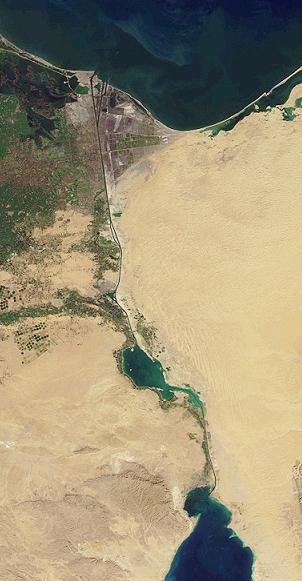*Image Credit: Wikimedia Commons Nearly 4,000 years after Pharaoh Senausert III dug the first waterway to link the Mediterranean and Red Seas, the Suez Canal opened in Egypt on November 17, 1869. Nicknamed “The Highway to India,” the decade-long project created one of the busiest and most vital shipping routes in the entire world. Though the first attempt to bridge the gap between the two chief bodies of water in the Middle East is said to have occurred in the 19th century BCE, modern interest in the possibility of a canal arose when Napoleon led the French Army into Egypt in 1798. As a team of scientists furiously hunted through the desert for the remains of the ancient waterway, slight miscalculations were relayed to the general — the Red Sea was believed to be 30 feet higher than the Mediterranean and the project would be too time-consuming to pursue. It would take nearly 50 years for the error to be corrected. Interest in cutting through the 100-mile stretch of parched earth took on a renewed importance by the middle of the 19th century, particularly when a second French study demonstrated the proposed route was essentially level from north to south. Ferdinand de Lesseps, working with Sa’id Pasha, the regional governor appointed by the Ottoman Empire, negotiated a 99-year lease on the territory in 1856 and spent another two years forming the company that would take on the massive effort. Work finally began on April 25, 1859, in what is now known as Port Said on the shores of the Mediterranean Sea. The British, in part attempting to maintain their hold on shipping to India, voiced disapproval and acted throughout the project to subvert the French effort to connect the seas to ships of any nation. When a diplomat decried the deaths of slaves, as many of the 30,000 people on the job each day were, construction came to a complete stop so employees could be hired to complete the backbreaking work under the excruciating heat. Pointing out the hypocrisy of statements against such a practice, de Lesseps argued there didn’t seem to be a problem when a British railroad used a similar workforce a few years before. By the time the Suez Canal opened on November 17, 1869, an estimated 1.5 million people had taken part in the construction and the price had doubled. As the French Empress Eugenie sailed through the waterway on the Aigle, she signalled the start of a new era — goods could now reach the other end of the world in record time. Deep in debt, the Suez Canal Company and its investors soon looked to raise revenues. Alterations were made to more accurately determine the net tonnage of ships passing through and, in order to ensure ships under any flag had access to the waterway, the British were called in to defend the region in 1888. Control has since moved over to the Egyptian Suez Canal Authority, yet it remains a key strategic hotspot — three conflicts have occurred in the area since the mid-1950s alone. Nowadays, as the canal approaches 150 years in business, plans are underway to accelerate the flow of traffic for the 1,400 vessels per month that make the journey between Port Said and the Suez Port by widening shipping lanes. And, by deepening the draft beyond the current 66-foot maximum, there is hope that someday soon all of the world’s ships will be able to slip through. Also On This Day: 1558 – Queen Mary I of England dies, putting Elizabeth I on the throne 1603 – Explorer Sir Walter Raleigh Goes on trial for treason in London 1800 – United States Congress holds its first session in Washington, DC 1989 – A student demonstration in Prague launches Czechoslovakia’s Velvet Revolution 1993 – The North American Free Trade Agreement is established by the United States House of Representatives
November 17th 1869 CE – The Suez Canal is Opened
*Image Credit: Wikimedia Commons Nearly 4,000 years after Pharaoh Senausert III dug the first waterway to link the Mediterranean and Red Seas, the Suez Canal opened in Egypt on November…
568
